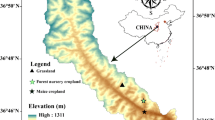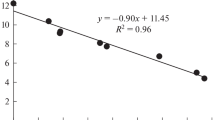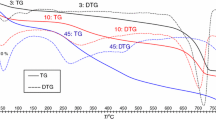Abstract
Dry combustion is a reliable method of determining soil C but like all methods has been challenged by the required scale. Several methods for measuring soil carbon stocks have been promoted in recent years as a way of dealing with the current soil C data crisis but techniques such as spectroscopy depend on standardisation by dry combustion. A new robust approach has been developed where the contents of whole soil cores are analysed by dry combustion to yield C data for full depth intervals. The system has a configuration which is based on extracting all C from a 50 cm long soil plug. The method relies on direct quantitative detection and minimising any interference from water. Apart from pre-drying to remove excess moisture, the flow-on benefits have been reduced time and associated costs in soil processing. The advantage is that this methodology captures the natural variability in all dimensions and can directly produce results on a volumetric (kg/m3) or gravimetric basis (g/kg). Determinations on cores have been reproduced within 0.1 % C (mass basis) which is the level of sensitivity required. The technique, which can be deployed on cores set out according to an appropriate sampling design, facilitates fast and cost effective determination of soil C stocks to support mapping, modeling and management.
Access provided by Autonomous University of Puebla. Download chapter PDF
Similar content being viewed by others
Keywords
Introduction
The reliable assessment and monitoring of soil carbon stocks is of key importance for soil conservation and in mitigation strategies for increased atmospheric carbon (Gehl and Rice 2007; Schrumpf et al. 2011). Carbon credits are the heart of a cap-and-trade scheme, by offering a way to quantify carbon sequestered from the atmosphere (IPCC 2006). The agricultural sector has the potential to capture and store carbon emissions in soil. However, there is no guarantee that the industry can benefit from the offsets in the current and future carbon economy because there is no efficient way of measuring soil carbon storage with appropriate statistical confidence for large areas. A successful method should deliver: reliable C data with requisite levels of precision, ease of application, cost effectiveness, and readily verified soil C data.
Technologies such as remote sensing and proximal sensing have been proposed for estimating surface soil carbon content over large areas (Gehl and Rice 2007). Such approaches only provides measurement on or near the soil surface, moreover the high cost of acquiring such data and the need for laboratory calibration limits its application in a routine auditing process. Field near infrared spectroscopy can give estimates of carbon, but the estimation is based on calibration to standard analytical techniques (error usually 1–8 g C/kg soil) (Bellon-Maurel and McBratney 2011).
Dry combustion of soils has been the benchmark method for soil C determination (Merry and Spouncer 1988; Wang and Anderson 1998; Conyers et al. 2011). It extracts C by converting it to CO2. Conventional methods for soil analysis are based on analysing an aliquot of the bulk soil sample, which means only one or a few grams of the soil core will be analysed. The dry combustion method on samples much larger than a few grams has generally been regarded as difficult to carry out due to incomplete conversion and in particular the huge volumes of gas that are generated. The issue surrounding small amounts necessitates greater sample handling and pre-processing e.g. selection, grinding, bulking and sub-sampling (added cost and labour) which can lead to deviations from the true composition and a loss of representativeness.
Here we demonstrate the possibility of analysing whole soil core by using a direct combustion technique that analyses the bulk soil gas composition. This has the potential to eliminate bias and error in sub-sampling for laboratory analysis and thus reduces the cost of sample preparation. Large aliquots in this study refer to amounts of 300–600 g, which is hundreds of times the mass of soil that is currently analysed for the determination of soil C stocks.
The Soil Carbon Bench
Classically, carbon is determined in a range of materials by combustion at temperatures usually over 800 °C and then determining the product by mass (gravimetric), titration or some other means (Rayment and Lyons 2011; Pallasser et al. 2013). Combustion is carried out in O2 rich atmospheres to achieve complete oxidation and any minor CO formed can be further converted catalytically. Anaerobic atmospheres produce pyrolysis products.
We designed and built an instrument which provides a novel way of measuring the soil carbon for a soil core of 300–500 cm3 or 300–600 g soil. The instrument called the soil carbon bench (SCB) was designed around these four main modules:
-
1.
Enclosed and refractory flow-through reactor tube with gas supply,
-
2.
Furnace mounted on rolling stock (mobile heat source),
-
3.
Split flow arrangement leading to measurement systems (e.g. gas chromatograph detector) and
-
4.
Data acquisition system and computer
To assist in monitoring combustions and devising the most effective methodology for determining C from soil cores, the SCB system was connected to a gas chromatograph (GC) fitted with a thermal conductivity detector. The SCB is a bulk C system that operates at over 800 °C and transfers heat into the 300 g+ soil mass to degrade and extract carbonaceous material including black carbon. Elemental analysers run at the same temperatures but transfer product gases in stages and remove water with hydrophilic traps.
The calibration for our Soil Carbon Bench instrument was based on the combustion of known amounts of pure carbonaceous materials. These became the internal standards and were primarily sugar (42 % C) and charcoal (70 %C) which were readily available. Combustion initially of neat (pure carbonaceous) material was replaced by synthetically prepared (i.e. organic bearing) soils, providing C in a soil matrix. The calibration summarised in Fig. 7.1, spans from 0.1 to 3.5 g C to cover the typical soil contents expected in field trials. While most attention was given to lower-end calibration, an upper limit for the system has not been reached.
Performance Parameters
This calibration function (Fig. 7.1) was linear with a standard error of prediction (SEP) (Fig. 7.1) of 0.17 g C. The limit of detection of the instrument is derived from the smallest measure that can be detected with reasonable certainty. There are a number of different “detection limits” that are commonly used, one of them being the method detection limit (MDL). The method detection limit (MDL) is a statistical approach based on replicate analyses at one particular concentration (Childress et al. 1999). This parameter quantifies the amount of signal unrelated to the analyte which is then used to determine LLD:
where the replicate analyses are carried out on the same (low) concentration over several days to capture all possible variables and the student’s coefficient (t-distribution, P = 0.01) given by the number of replicates. Accordingly, the MDL and LLD were determined for the SCB based on repeated aliquots of soil containing 0.35 g C (representing low end of scale) analysed over different days. The standard deviation for the test values was 0.03 with the t-test value for n = 9 at 99 % confidence level, yielding the MDL of 0.085 g C.
Laboratory Testing
In order to demonstrate how accurately and reproducibly the SCB system could deliver results in comparison to the industry standard it was necessary to conduct conventional soil carbon analyses. These were carried out on the small amounts of soil necessary for the elemental analyser (EA) (Elementar vario Max, Hanau Germany). Soil samples (mainly from Lansdowne, NSW) were air-dried, and well homogenised. SCB takes about 200–300 g of soil, while the elemental analyser takes approximately 0.5 g of soil materials. The results on the comparison of the two methods are presented in Fig. 7.2.
Elemental analysers are precise instruments capable of replicating results below 0.1 % C when using similar masses of homogenous soil. All soils were dried prior to analysis so that values could be expressed on a standard oven-dried basis. The mean difference between the two determination methods was 0.12 % C. It must be noted these were not measures of precision which are closer for individual instruments. These variations rather than being due to calibration can probably be attributed to heterogeneity of C within the sample. Heterogeneity has an impact using standard C analyses but not with the SCB because it analyses the whole soil mass.
Field Testing
The SCB was tested from soil samples collected in a field at Lansdowne Farm, near Cobbitty, NSW, Australia. Soil texture varied from sandy loams to sandy clay loams along a North to South transect. The area consisted of a good grading of particle-sizes and carbon content ranging from a proven 0.2 % in the sandier parts up to 1–2 % in surface clay loams close to the river.
In order to develop a method that allowed C data to be expressed on a volumetric basis a method of obtaining reliable soil cores was an important requirement. Obtaining soils from known volumes avoids the issues of bulk density correction as described by Lee et al. (2009), which include the complicated calculation of equivalent soil mass. Several soil recovery tools including 50 cm vibracore were tested for the most suitable soil plugs in terms of uniformity and a volume of soil that could be processed in the SCB. The samplers (Fig. 7.3) were drawn down at the cutting end from the standard 38 mm tubes so that a volume/mass of soil appropriate for the SCB (~450 cm3 or 600 g) could be recovered up to 1 m depth. Each core results in one C value.
The processing requirement for this analysis is breaking up the soil and pre-drying (at 90 °C for a minimum of 12 h) to remove excess moisture. The replicate results for whole core analyses from each sampling location over the study area are shown in Fig. 7.4. The results can be expressed as g C per whole core interval (50 cm), % C of total dry mass or C stock (in kg/m2). The soil C values from the cores were coherent (per site and trend down transect) and varied less compared to measurements using elemental analysis. Total C per core was within 0.2 g of their mean for each site where the totals ranged from 0.7 to 4.7 g C per 50 cm core for the sampled positions over the transect. On a gravimetric basis (the ranges are 0.2–1.09 % C per 50 cm core) the site reproducibility was around 0.0003 kg/kg. Both EA and SCB produce similar mean values across the transect (mean = 4.2, median = 4.1 kg/m2), however the values obtained by SCB has smaller variance (std. deviation = 0.97, interquartile range = 1.08 kg/m2) when compared to values obtained by EA (std. deviation = 1.36, interquartile range = 2.71 kg/m2).
Conclusions
This methodology for sampling and analyzing soil C captures the natural variability and can directly produce results on a volumetric (kg/m3) or gravimetric basis (g/kg), making it amenable to protocols proposed under IPCC. Determinations on cores have been reproduced within 0.1 % C (mass basis) which is the level of sensitivity required. Apart from pre-drying to remove excess moisture, the flow-on benefits have been reduced time and associated costs in soil sample preparation. Based on our initial trial work, time savings have been estimated to be over 60 % resulting in lower analysis costs which could become as low as 20 % that of conventional methods.
References
Bellon-Maurel V, McBratney A (2011) Near-infrared (NIR) and mid-infrared (MIR) spectroscopic techniques for assessing the amount of carbon stock in soils–critical review and research perspectives. Soil Biol Biochem 43:1398–1410
Childres CJO, Foreman WT, Connor BF, Maloney TJ (1999) New reporting procedures based on long-term method detection levels and some considerations for interpretations of water-quality data provided by the U.S. Geological Survey National Water Quality Laboratory. U.S. Geological Survey Open-File Report 99–193
Conyers MK, Poile GJ, Oates AA, Waters D, Chan KY (2011) Comparison of three carbon determination methods on naturally occurring substrates and the implication for the quantification of ‘soil carbon’. Soil Res 49:27–33
Gehl RJ, Rice CW (2007) Emerging technologies for in situ measurement of soil carbon. Clim Chang 80:43–54
IPCC (2006) In: Eggleston, Buendia L, Miwa K, Ngara T, Tanabe K (eds) IPCC guidelines for national greenhouse gas inventories, vol 4. Agriculture, forestry and other land use. IGES, Japan
Lee J, Hopmans JW, Rolston DE, Baer SG, Six J (2009) Determining soil carbon stock changes: simple bulk density corrections fail. Agric Ecosyst Environ 134:251–256
Merry RH, Spouncer LR (1988) The measurement of carbon in soils using a microprocessor-controlled resistance furnace. Commun Soil Sci Plant Anal 19:707–720
Pallasser R, Minasny B, McBratney AB (2013) Soil carbon determination by thermogravimetrics. Peer J 1:e6. doi:10.7717/6
Rayment GE, Lyons DJ (2011) Soil chemical methods – Australasia. CSIRO Publishing, Collingwood
Schrumpf M, Schulze ED, Kaiser K, Schumacher J (2011) How accurately can soil organic carbon stocks and stock changes be quantified by soil inventories? Biogeosci Discuss 8:723–769
Wang D, Anderson DW (1998) Direct measurement of organic carbon content in soils by the Leco CR‐12 carbon analyzer. Commun Soil Sci Plant Anal 29:15–21
Author information
Authors and Affiliations
Corresponding author
Editor information
Editors and Affiliations
Rights and permissions
Copyright information
© 2014 Springer International Publishing Switzerland
About this chapter
Cite this chapter
Pallasser, R., Minasny, B., McBratney, A.B. (2014). A Novel Method for Measurement of Carbon on Whole Soil Cores. In: Hartemink, A., McSweeney, K. (eds) Soil Carbon. Progress in Soil Science. Springer, Cham. https://doi.org/10.1007/978-3-319-04084-4_7
Download citation
DOI: https://doi.org/10.1007/978-3-319-04084-4_7
Published:
Publisher Name: Springer, Cham
Print ISBN: 978-3-319-04083-7
Online ISBN: 978-3-319-04084-4
eBook Packages: Earth and Environmental ScienceEarth and Environmental Science (R0)








